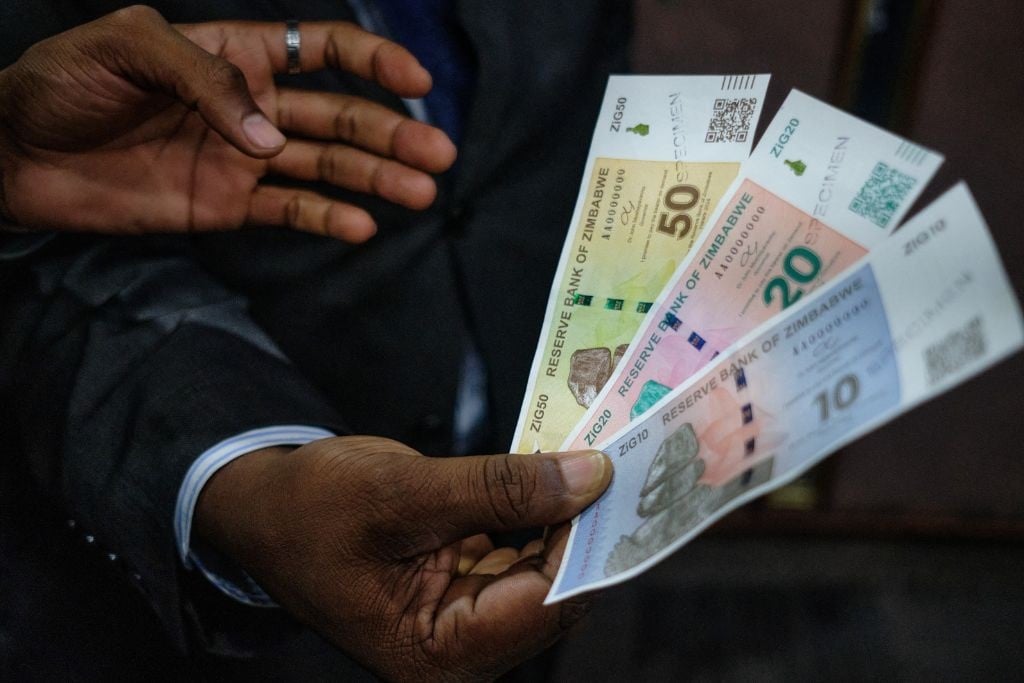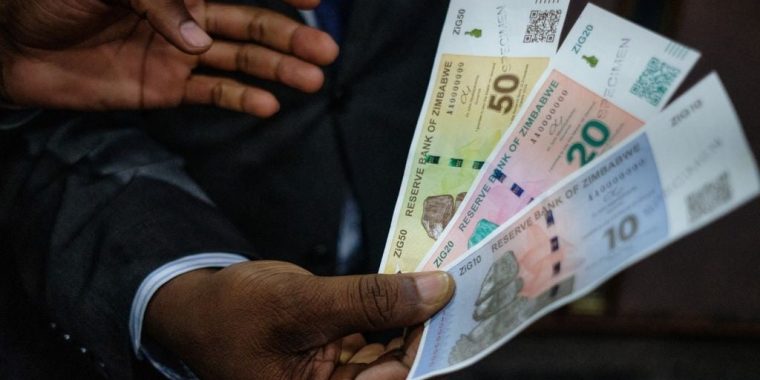
Zimbabwe
Reserve
Bank
Governor
John
Mushayavanhu
presented
his
monetary
policy
statement,
during
which
he
announced
the
launch
by
the
central
bank
of
the
ZiG
(Zimbabwe
Gold).
(Jekesai
Njikizana/
AFP)
-
Earlier
this
month
Zimbabwe
introduced
a
new
currency,
the
ZiG,
short
for
Zimbabwe
Gold. -
The
move
is
an
effort
to
stabilise
the
volatile
exchange
rate
that
has
roiled
the
country’s
retail
sector. -
While
businesses
rush
to
adapt
to
the
ZiG,
one
of
the
biggest
concerns
is
whether
it
will
create
a
parallel
currency
market
—
which
could
threaten
its
exchange
rate
stability. -
For
more
financial
news,
go
to
the News24
Business
front
page.
From
the
tiny
space
he
rents
in
the
central
business
district
of
Bulawayo,
Zimbabwe’s
second-largest
city,
Brian
Tinotenda
can
look
across
the
street
and
see
the
supermarket where
he
used
to
work.
Along
with
nearly
two
dozen
other
informal
traders,
Tinotenda
pays
roughly
$200
(R3
800)
a
month for
the
small
space
from
which
he
sells
toiletries
and
foodstuff
such
as
rice,
cooking
oil
and
cornmeal
–
the
same
products
he
sold
at
the
Spar
Group
before
starting
his
own
business
in
2021.
While
there
are
many
differences
between
his
new
job
and
his
last,
one
of
the
big
ones
is
that
now
all
of
his
wares
are
priced
in
US
dollars.
The
Zimbabwean
government
is
hoping
to
change
that.
Earlier
this
month,
it
introduced
a
new
currency,
the
ZiG,
short
for
Zimbabwe
Gold.
The
ZiG
is
backed
by
2.5
tons
of
gold
and
about
$100
million
in
foreign
currency
reserves
held
by
the
central
bank,
and
a
single
ZiG
is
worth
about
7
US
cents,
the
price
of
a
milligram
of
gold.
The
move
is
an
effort
to
stabilise
the
volatile
exchange
rate
that
has
roiled
the
country’s
retail
sector
and
given
an
upper
hand
to
informal
traders
like
Tinotenda.
For
more
than
a
decade,
Zimbabwe
has
been
struggling
with
a
currency
crisis
sparked
by
the
government’s
decision
to
keep
printing
money.
That
has
fuelled
hyper-inflation,
which
in
2008
reached
the
official
rate
of
500
billion
percent.
To
get
things
under
control,
the
country
adopted
greenbacks
for
more
than
a
decade,
before
switching
back
to
Zimbabwean
dollars
in
2019.
The
trouble
is
that,
while
businesses
have
been
forced
to
use
Zimbabwean
dollars
at
an
official
exchange
rate
set
by
the
central
bank
–
which
is
widely
seen
as
overvalued
–
traders
have
stuck
with
the
more
stable
American
dollar.
This
has
meant
that
retailers
have
been
obliged
to
sell
items
at
prices
that
are
often
significantly
more
expensive
in
US
dollar
terms
than
those
same
items
for
sale
on
the
street.
The
policy
has
been
a
boon
to
informal
traders,
as
80%
of
all
commerce
is
conducted
in
US
dollars.
It’s
also
been
a
serious
liability
for
major
retailers
such
as
the
Johannesburg
Stock
Exchange-listed
Pick
n
Pay
Stores
Ltd.
and
rival
OK
Zimbabwe
Ltd.,
which
has
operated
in
the
country
for
82
years.
With
inflation
soaring
—
it
hit
55%
in
March
—
and
the
local
currency
prone
to
wild
swings,
exchange-rate
losses
have
eroded
the
value
of
earnings.
The
exchange
rate
restrictions
created
a
“huge
disadvantage”
for
“compliant
businesses
who
grapple
with
taxes,
licensing,
labour
costs
and
rentals,”
said
Denford
Mutashu,
president
of
the
Confederation
for
Zimbabwe
Retailers.
The
IMF
has
cautioned
that
they
“promote
informality,
which
erodes
the
tax
base
and
undermines
longer-term
growth.”
Retailers
have
been
even
more
blunt.
OK
Zimbabwe,
which
makes
only
20%
of
its
revenue
in
US
dollars,
said
the
policy
puts
businesses
at
risk
of
“forced
death.”
The
ZiG
is
an
“effectively
revalued”
Zimbabwe
dollar,
said
Tony
Hawkins,
a
Harare-based
economist
and
a
former
economics
professor
at
the
University
of
Zimbabwe.
To
support
the
new
currency
and
spur
growth
curtailed
by
high
borrowing
costs,
the
central
bank
reset
interest
rates
from
130%,
a
world
record,
to
20%.
And
so
far,
the
ZiG
is
off
to
a
promising
start
—
after
more
than
a
week
of
trading,
it
has
gained
1.5%
against
the
US
dollar.
That’s
a
significant
change
from
the
Zimbabwean
dollar
it’s
replacing.
When
the
dollar
was
handed
its
death
sentence
on
April
5,
it
was
one
of
the
world’s
worst
performing
currencies,
trailing
behind
only
the
Lebanese
pound.
It
lost
value
every
single
trading
day
of
this
year.
Another
factor
that
authorities
hope
will
help
the
ZiG
succeed
is
that
businesses
will
no
longer
be
forced
to
stick
to
a
fixed
exchange
rate.
Assuming
the
currency
stays
stable,
said
John
Mushayavanhu,
Governor
of
the
Reserve
Bank
of
Zimbabwe,
retailers
now
run
the
risk
of
driving
themselves
“out
of
the
market”
if
they
raise
prices
too
much.
While
businesses
rush
to
adapt
to
the
ZiG,
one
of
the
biggest
concerns
is
whether
it
will
create
a
parallel
currency
market
—
which
could
threaten
its
exchange
rate
stability.
If
the
ZiG’s
value
were
to
rise
or
fall
in
the
informal
sector,
for
instance,
that
could
have
an
effect
on
the
prices
of
goods
and
services,
which
could
then
be
reflected
in
the
official
exchange
rate.
According
to
the
Harare-based
brokerage
firm IHS
Securities
Ltd., it’s
just
a
matter
of
time
before
this
takes
place.
It’s
likely that
“some
form
of
parallel
market
will
emerge
as
a
significant
portion
of
the
population
remains
unbanked,”
it
said
in
an
April
8
note
to
clients.
“It
is
yet
to
be
seen
what
level
the
parallel
rate
will
settle
at.”
A
street
market
price
of
16
ZiG
per
dollar
was
being
quoted
Tuesday
by
ZimPriceCheck.Com,
a
website
that
tracks
official
and
parallel
exchange
rates.
The
majority
of
Zimbabwe’s
6.3
million
working
people
are
informally
employed,
according
to
the
country’s
national
statistics
agency. Wholesale
and
retail
trading
of
goods
such
as
soft
drinks,
perfumes
and
even
diapers
is
common,
and
many
traders
work
out
of
“tuck-shops”
—
tiny
spaces
in
densely
packed
buildings.
Those
who
want
to
avoid
overhead
costs
might
sell
from
the
trunk
of
a
car
or
by
the
side
of
the
road.
The
Reserve
Bank
of
Zimbabwe
estimates
that
the
informal
sector
generates
$14
billion
in
annual
revenue.
The
World
Bank
has
called
Zimbabwe’s
black
economy
—
which
operates
on
a
strictly
cash
basis
—
the
world’s
second-largest
after
Bolivia.
Impromptu
markets
and
tuck-shops
are
so
popular
that
some
major
retailers
have
linked
them
to
a
decline
in
foot
traffic.
In
downtown
Bulawayo’s
central
business
district,
informal
traders
sit
along
a
row
of
sky-blue
make-shift
tents
hawking
bales
of
second-hand
clothes
and
electronics.
Known
as
“mabhero,”
the
bales
come
from
neighboring
countries
such
as
Mozambique
and
Zambia,
where
traders
buy
goods
in
US
dollars
to
bring
back
to
Zimbabwe.
Clothes
are
laid
out
in
piles
on
the
ground
for
pedestrians
to
stop
and
pick
through.
These
mabhero
sellers
are
eating
into
the
margins
of
larger
clothing
competitors
such
as
Edgars
Stores
Zimbabwe
and
Truworths
Ltd
Zimbabwe.
Sales
have
declined
due
to
“cheap
and
fake
imports
selling
at
below
local
and
international
manufacturing
costs,”
said
Truworths
in
a
March
financial
results
release,
adding
that
it
“cannot
viably
compete.”
Such
cross-border
imports
aren’t
limited
to
clothes:
On
social
media,
some
sellers
even
offer contraband Starlink
terminals.
These
Space
X-made
kits,
which
aren’t
yet
legal
in
Zimbabwe,
sell
for
between
$1
000
and
$1
250
US.
As
retailers
continue
to
lose
ground
to
informal
sellers,
many
are
hoping
the
ZiG
will
offer
relief.
Because
it
isn’t
pegged
to
a
fixed
exchange
rate,
Maxen
Karombo,
chief
executive
officer
of
OK
Zimbabwe,
said
he’s optimistic
about
it.
“This
should
bode
well
for
all
in
retail,”
Karombo
wrote
in
response
to
questions,
“as
we
now
compete
on
the
basis
of
value.”
Mike
Kamungeremu,
president
of
the
Zimbabwe
National
Chamber
of
Commerce,
said
the
plan
is
to
“give
ZiG
a
chance”
and
to
review
the
new
currency’s
effectiveness
and
impact
by
June.
Still,
as
Imara
Asset
Management,
the
country’s
biggest
independent
brokerage,
observed
in
a
recent
quarterly
note,
breaking
up
with
the
US
dollar
will
be
a
challenge.
As
the
informal
market
has
grown,
some
big
manufacturers
now
prefer
to
operate
in
it.
Among
the
businesses
that
straddle
both
sectors
are
Zimbabwe’s
two
largest
bread
manufacturers,
who
supply
tuck-shops
and
roadside
traders
with
bread
every
morning.
The
wholesale
price
for
a
loaf
of
bread
is
80
US
cents,
Tinotenda
explained,
and
most
informal
traders
price
them
at
$1.
“But
walk
into
the
supermarket,
there
they
sell
the
same
bread
for
$1.20,”
he
said.
“No
one
buys
it.”

